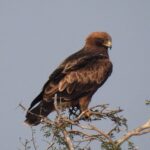The booted eagle (Hieraaetus pennatus) is a medium-sized bird of prey that is mostly migratory, with a wide distribution in the Palearctic and southern Asia. It winters in the tropics of Africa and Asia, and has a small, disjunct breeding population in south-western Africa. The booted eagle is a trans-Saharan migrant, spending its summers in its northern region in Europe to Asia and wintering in the Sahel region and tropical Africa.
Booted Eagle’s Preferred Habitats
Booted eagles are found in a variety of habitats across their range, including:
- Marshes: Booted eagles are known to inhabit marshes, where they can find a variety of prey and suitable nesting sites.
- Scrublands: These birds thrive in scrubland environments, where they can hunt and nest in the scattered vegetation.
- Scattered Cork Oaks and Stone Pines: Booted eagles are often found in areas with scattered cork oaks and stone pines, which provide a mix of open and forested areas for hunting and nesting.
- Sand Dunes along Coastlines: Booted eagles have been observed in coastal areas, where they can take advantage of the diverse prey and nesting opportunities offered by sand dunes.
- Forests and Woodlands: The booted eagle is commonly found in forests and woodland areas, particularly in the Iberian Peninsula, where they inhabit mixtures of pine forests, open lands, and mountain slopes.
- Hilly and Open Landscapes: In Southern Africa, booted eagles are found in hilly and open landscapes, typically breeding on rocky cliffs in ravines and gorges, and occasionally nesting in trees such as Euphorbias.
- Fynbos and Karoo Ecotone: This bird is most common in the low stature shrublands of the Fynbos and Karoo, and more specifically the ecotone between the two biomes.
Preferred Hunting Grounds
 Image source: Booted eagle By Dr. Raju Kasambe
Image source: Booted eagle By Dr. Raju Kasambe
Booted eagles prefer woodland areas, but without too dense forest growth. In areas with dense forests, they hunt in clearings and at the forest edges. They also hunt in open landscapes, such as grassland and semi-arid zones.
Hunting Strategies and Diet
Booted eagles have a diverse diet that includes:
- Birds
- Small mammals
- Reptiles
- Rodents
- Amphibians
- Insects
They hunt their prey by:
- Perching from a lookout
- Perching on the ground
- Circling open country at 10-250 meters
- Occasionally chasing birds throughout the tree canopy
However, the majority of their prey is caught on the ground. In Southern Africa, booted eagles hunt small mammals, reptiles, and birds.
Conservation Status and Threats
The conservation status of the booted eagle is classified as “Least Concern” by BirdLife International. However, many local populations in Europe are very small, which makes them vulnerable to changes, and so should be closely monitored.
The main threats for booted eagles include:
- Habitat loss and degradation
- Power line electrocution
- Occasional forest fires
- Poor forest management
- Deforestation
- Direct persecution
- Climate change
To ensure the continued survival of the booted eagle, it is crucial to address these threats and maintain the diverse habitats that this majestic raptor relies on.
References:
– https://animaldiversity.org/accounts/Hieraaetus_pennatus/
– https://europeanraptors.org/booted-eagle/
– https://animalia.bio/booted-eagle?environment=434
– https://en.wikipedia.org/wiki/Booted_eagle

